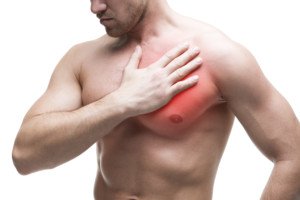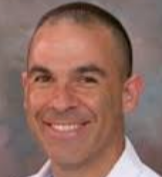
A cardiologist addresses whether a pulled chest muscle has different features than a heart problem or angina and vice versa.
A pulled or strained chest muscle is no picnic to have. It can hurt.
And sometimes, the discomfort doesn’t kick in till the day after a chest workout—making it, in a way, seem less likely connected to your bench pressing, pushups or whatever.
(Though any fitness aficionado would be very familiar with delayed onset muscle soreness.)
Differences Between Strained Chest Muscle and Cardiac Pain, Angina
“Musculoskeletal chest pain tends to be quite different from worrisome heart pain,” says Alvaro Waissbluth, MD, an Ohio-based heart surgeon board certified in interventional cardiology and cardiovascular diseases, and founder of Eat Tank, an educational nutrition initiative that provides simple tools and practical knowledge for better understanding food.
Dr. Waissbluth continues, “Musculoskeletal chest pains almost always change with physical movement of the chest wall either from breathing or moving one’s arms or body.
“This causes tension on the actual muscles or tendons or ligaments or joints that are inflamed and makes them hurt.”
This is a hallmark feature of chest muscle soreness.
Like any sore or strained muscle, the pain will fluctuate or be aggravated with movement.
“Also, musculoskeletal chest pains are often fleeting – lasting a few seconds at most –and go away when the movement is over.”
Angina doesn’t last for three seconds.
Pay attention to your movements.
What motions did you carry out just before that fleeting “chest pain”?
The offending motion could have even been committed while you were seated—simply twisting in your chair, pressing a hand against the armrest, may be all it takes to buzz the strained chest muscle.
“They are rarely accompanied by other symptoms and typically don’t radiate anywhere else,” says Dr. Waissbluth, referring to musculoskeletal pain.
If you seemingly have persistent chest pain that you suspect is from a gym workout, pay very close attention to your breathing.
You may find that the pain surfaces only at the bottom of an exhalation or at the top of an inhalation, but it seems as though the chest pain is persistent or constant because you’re taking breaths every several seconds.
Take an exaggerated exhalation or inhalation to see if either bring out the discomfort.
Hold your breath to see if the discomfort vanishes!
Holding your breath won’t make angina or other heart pain vanish!
“Chest pain from heart problems, on the other hand, almost never changes with breathing or moving around, is usually in the middle of the chest or left sided, often radiates to the left arm and/or neck and/or jaw and/or shoulder and/or back, is often associated with shortness of breath, nausea and/or sweating, and lasts typically minutes or longer,” explains Dr. Waissbluth.
This isn’t to say, however, that angina can’t ever present as just chest pain only or right-side dominant.
But remember, angina or cardiac pain won’t fluctuate, improve or worsen with changes in breathing and body position.
Dr. Waissbluth continues, “Whereas musculoskeletal pains change with sitting in place and moving one’s torso or arms or taking a deep breath, it is actual physical exertion such as climbing stairs or walking up a hill or carrying something that can precipitate chest pain from a heart problem.”
Gee, how could that sudden “chest pain” while you’re sitting at your computer (when your oxygen demands are thus very low) be from a heart problem when just yesterday you did 50-pound kettlebell swings and 6 RM bench presses (huge oxygen demands) without incident?

Shutterstock/Jasminko Ibrakovic
“But you don’t need to move at all [trot up stairs, shovel snow, lift heavy box, run on treadmill] to have chest pain from a heart problem – as if a plaque ruptures and causes a heart attack while you’re sleeping or watching TV, you can have typical heart chest pain just lying or sitting there.”
Of course, chest pain from a plaque rupture won’t be fleeting.
People who’ve suffered plaque ruptures will tell you that the pain didn’t get better or subside; it persisted, perhaps became worse, and was (most very likely) accompanied by other frightening symptoms such as shortness of breath and profuse sweating.
Dr. Waissbluth adds, “However there is no absolute rule! These are guidelines. Any chest pain of any quality should be reported to your doctor to figure out.”
To non-invasively find out if you have an abnormal amount of soft plaque in your coronary arteries (the type that can rupture), you’d have to undergo a magnetic resonance angiogram — and this procedure is not given to asymptomatic people as a screening tool for heart disease.
You can kick back soft plaque buildup by cutting back (and a LOT, not a little) on processed foods!
As for chest muscle pain, make a habit of warming up generously prior to chest routines, and keep in mind that back routines can aggravate chest muscles.

Dr. Waissbluth is affiliated with Atrium Medical Center and has been in practice for 25+ years. Visit Eat Tank.
 Lorra Garrick has been covering medical, fitness and cybersecurity topics for many years, having written thousands of articles for print magazines and websites, including as a ghostwriter. She’s also a former ACE-certified personal trainer.
Lorra Garrick has been covering medical, fitness and cybersecurity topics for many years, having written thousands of articles for print magazines and websites, including as a ghostwriter. She’s also a former ACE-certified personal trainer.
Top image: Shutterstock/staras
Stabbing Chest Pain when Lying on Left Side: Heart or Muscle?
Chest Pain with Hoarse Voice: May Be Cancer or Aortic Aneurysm












